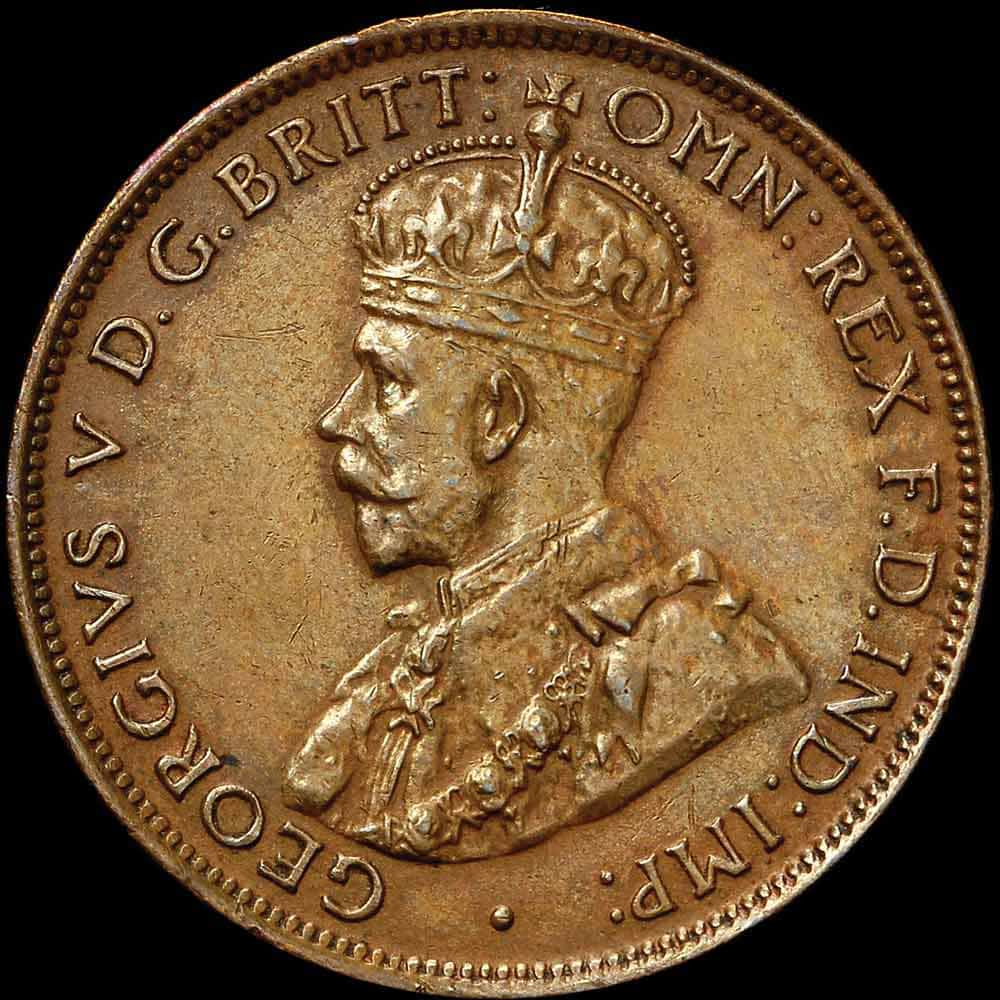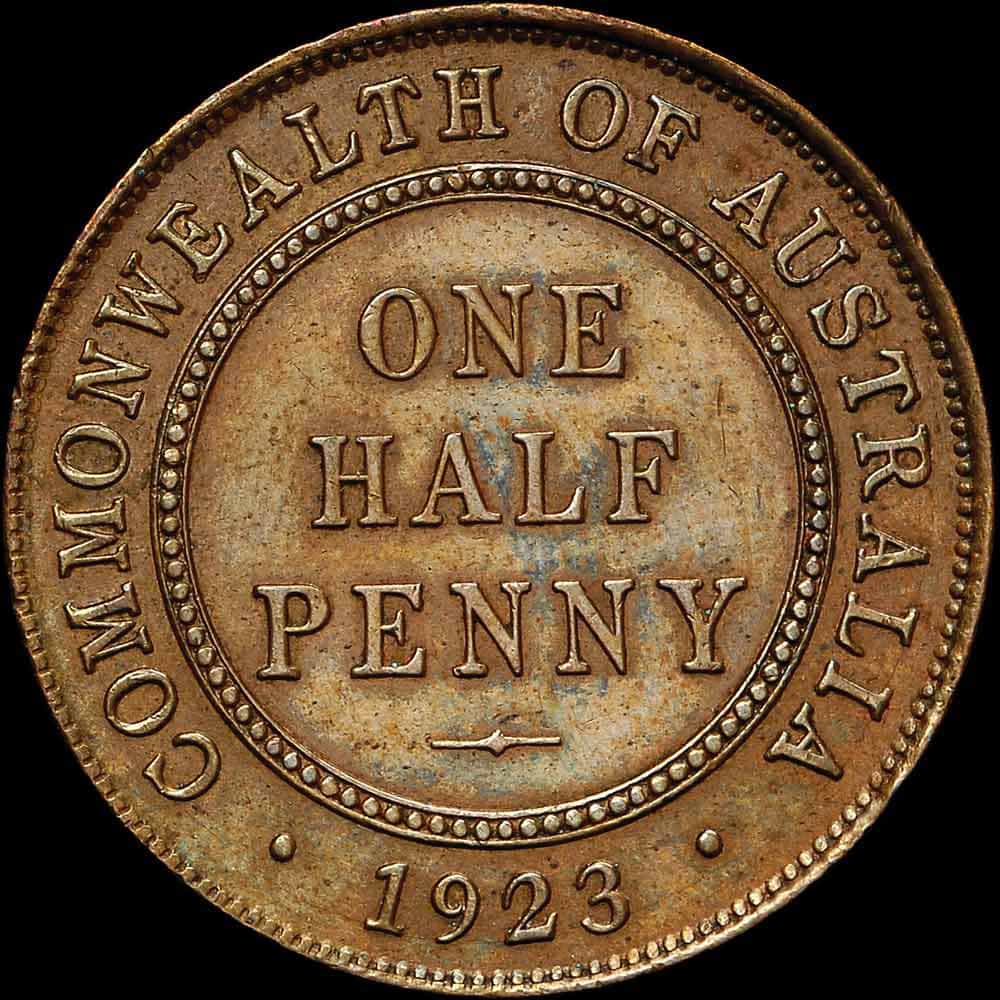Australia 1923 Halfpenny
| Mint: | Melbourne | Mintage: | Est 21,000 | Milling: | Plain |
| Weight: | 5.67 grams | Diameter: | 25.5 mm | Composition: | 97% Copper, 2.5% Zinc, 0.5% Tin |
|
Click to enlarge
Wear
Next
Prev

Obverse 1 - English
|
Click to enlarge
Wear
Next
Prev

Reverse A - London
|
||||||||||||||||||||||||||||||||||||||||||||||||||||||||||||||||||||||||
|
|
||||||||||||||||||||||||||||||||||||||||||||||||||||||||||||||||||||||||
| Click on Wear to show high points first susceptible to wear | |||||||||||||||||||||||||||||||||||||||||||||||||||||||||||||||||||||||||
Value
|
BM
Ad
NP
|
8
Good
VG10
|
10
VG
F12
|
12
about F
F15
|
15
Fine
VF20
|
20
good F
VF25
|
25
about VF
VF30
|
30
Very Fine
VF35
|
35
good VF
EF40
|
40
about EF
EF45
|
45
Ext Fine
AU50
|
50
good EF
AU53
|
53
about Unc
AU55
|
58+
virt Unc
AU58
|
58-60
Uncirc
MS60
|
58-61
Uncirc
MS61
|
58-62
Uncirc
MS62
|
63-64
Choice Unc
MS63
|
64-65
near Gem
MS64
|
65-66
Gem
MS65
|
66-67
Gem
MS66
|
67-68
Gem
MS67
|
68
near Flaw
MS68
|
69
virt Flaw
MS69
|
70
Flawless
MS70
|
Proof
|
|---|---|---|---|---|---|---|---|---|---|---|---|---|---|---|---|---|---|---|---|---|---|---|---|---|---|
| B |
$300
+
NGC
1
PCGS
1
|
$400
+
NGC
PCGS
3
|
$600
+
NGC
11
PCGS
5
|
$1250
+
NGC
PCGS
15
|
$1500
+
NGC
PCGS
27
|
$1750
+
NGC
10
PCGS
53
|
$2250
+
NGC
PCGS
66
|
$2750
+
NGC
6
PCGS
68
|
$4000
+
NGC
15
PCGS
62
|
$6000
+
NGC
PCGS
21
|
$9000
+
NGC
1
PCGS
15
|
$15000
+
NGC
5
PCGS
15
|
$25000
+
NGC
2
PCGS
10
|
$35000
+
NGC
PCGS
|
$50000
+
NGC
PCGS
|
$75000
+
NGC
1
PCGS
2
|
$125000
+
NGC
PCGS
1
|
$175000
+
NGC
PCGS
|
-
+
NGC
PCGS
|
-
+
NGC
PCGS
|
-
+
NGC
PCGS
|
-
+
NGC
PCGS
|
-
+
NGC
PCGS
|
-
+
NGC
PCGS
|
Y
|
| RB |
"
+
NGC
PCGS
|
"
+
NGC
PCGS
|
"
+
NGC
PCGS
|
"
+
NGC
PCGS
|
"
+
NGC
PCGS
|
"
+
NGC
PCGS
|
"
+
NGC
PCGS
|
"
+
NGC
PCGS
|
$7500
+
NGC
PCGS
1
|
$10000
+
NGC
PCGS
|
-
+
NGC
PCGS
|
-
+
NGC
PCGS
|
-
+
NGC
PCGS
|
-
+
NGC
PCGS
|
-
+
NGC
PCGS
|
-
+
NGC
PCGS
|
-
+
NGC
PCGS
|
-
+
NGC
PCGS
|
-
+
NGC
PCGS
|
-
+
NGC
PCGS
|
-
+
NGC
PCGS
|
-
+
NGC
PCGS
|
-
+
NGC
PCGS
|
-
+
NGC
PCGS
|
Y
|
| R |
"
+
NGC
PCGS
|
"
+
NGC
PCGS
|
"
+
NGC
PCGS
|
"
+
NGC
PCGS
|
"
+
NGC
PCGS
|
"
+
NGC
PCGS
|
"
+
NGC
PCGS
|
"
+
NGC
PCGS
|
"
+
NGC
PCGS
|
"
+
NGC
PCGS
|
"
+
NGC
PCGS
|
"
+
NGC
PCGS
|
-
+
NGC
PCGS
|
-
+
NGC
PCGS
|
-
+
NGC
PCGS
|
-
+
NGC
PCGS
|
-
+
NGC
PCGS
|
-
+
NGC
PCGS
|
-
+
NGC
PCGS
|
-
+
NGC
PCGS
|
-
+
NGC
PCGS
|
-
+
NGC
PCGS
|
-
+
NGC
PCGS
|
-
+
NGC
PCGS
|
Y
|
BM
Benchmark
Ad
Adjectival
NP
NGC/PCGS
Collectable grades
Does not exist by definition
Investment grades
-
Unlikely to exist
Aspirational grades
BV
Bullion or metal value
Not known in these grades
''
Value as above
Proof
Y (Yes)
N (Not known)
N (Not known)
Last updated July 2024
Notes:
In July 1923, the Australian Treasury ordered from the Melbourne Mint £1,000 of halfpennies and in September of that year three pairs of dies were prepared to strike the coins. This was the first time that the Melbourne Mint struck halfpennies, and the dies that were made were of such a poor standard as one pair of dies was immediately returned to the workshop. The two remaining pairs that were used to strike coins deteriorated so quickly that the vast majority of 1923 halfpennies exhibit diagnostic die cracks particularly in the obverse legend. Another tell-tale marker of the 1923 Halfpenny also relates to the obverse. Two of the high-grade coins that have been observed have grainy or porous services on the obverse which indicates that at least one of the obverse dies that was used was rusty indicating prior use, thus raising the prospect that they were possibly redundant dies recalled from the Sydney Mint which had previously been responsible for striking the 1919, 1929, 1921 & 1922 halfpennies. Only a small number of coins were struck before the dies ultimately failed making this one of the rarest halfpennies and so open to forgery.
The most common 1923 Halfpenny forgery found in old collections involved removing parts of the left side of the '8' in the date of the 1928 Halfpenny to approximate a '3'. Besides the shape of the resultant '3' being thinner in form, the centre divide is also straight rather than tilted down as occurs on the 1923 Halfpenny. The legend on the reverse of the 1923 Halfpenny is also straight based when compared to that of the 1928 Halfpenny which is slightly curved.
Another commonly found forgery involved replacing the first '3' in the date of a 1933 Halfpenny with a '2', as most people are inclined to look at the last digit when determining whether a 1923 Halfpenny is genuine. Even if you can't pick the altered date you should look to the legend, as the 1933 Halfpenny has strong curvature to the base of the letters on the reverse when compared to the straight based letters found on the 1923 Halfpenny.
